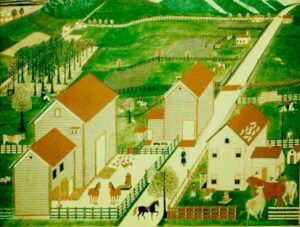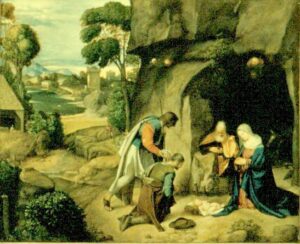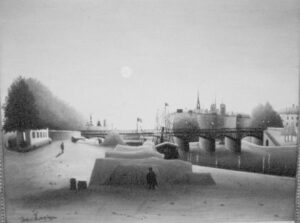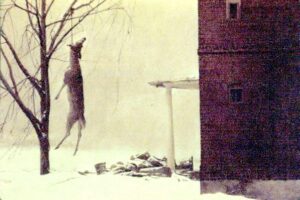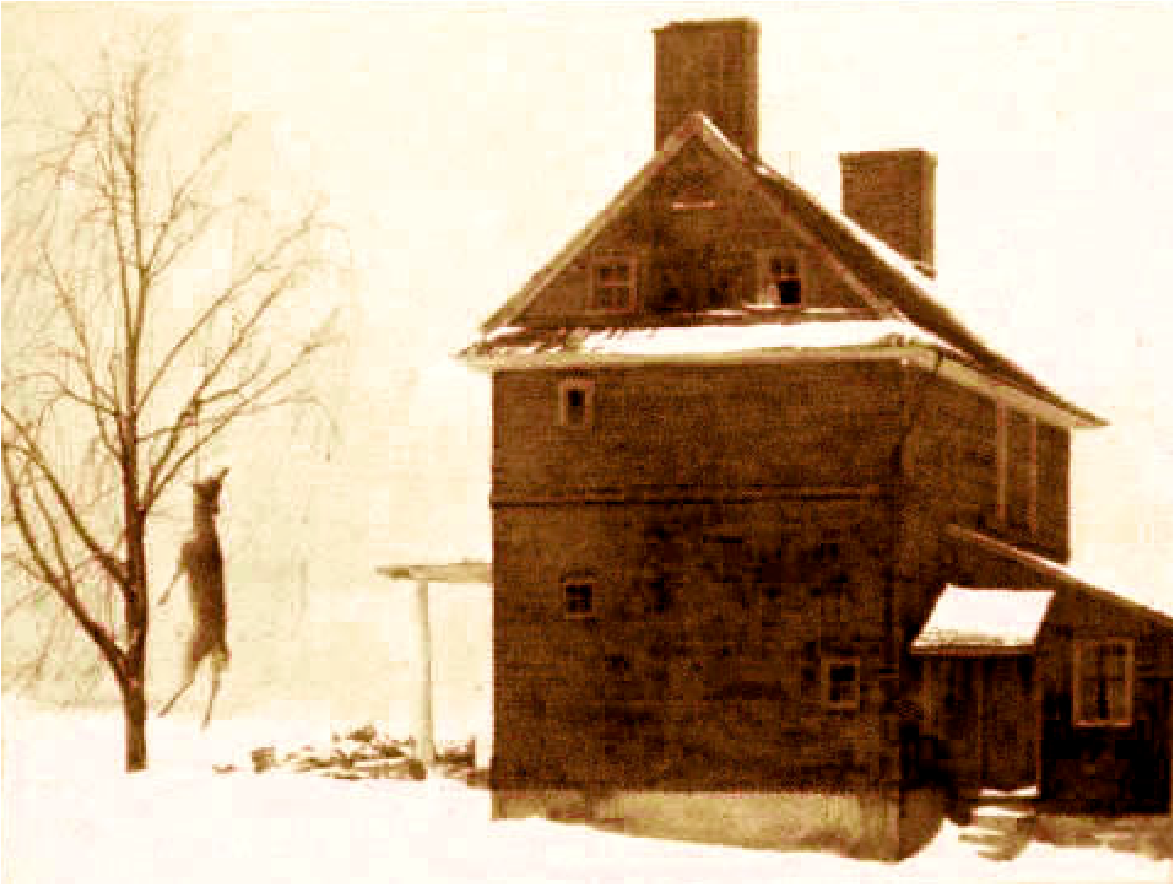The Quest for Reality
–

Image of God the Father (Fig. 10-1, c. 1432 ) by Jan and Hubert Van Eyck, defines “reality” in terms of material trappings of an Eastern potentate.
There is always something unsettling about representations of the ineffable, the “inexpressible” or “that which is too holy to be spoken.” Yet, in virtually every culture, man has been tempted to embody the “unspeakable” in tangible form.
These “perfectionist” expressions of human consciousness may paradoxically provide one of the clearest windows though which we can better understand our bias concerning “artistic truthfulness.” We have a whole gamut of language directed at comprehension of “truth as we see it,” and it is through analysis of that language that I hope we can sharpen appreciation of the issues involved.
Let’s look for a moment at a rendition by brothers, Jan and Hubert Van Eyck, depicting God the Father (Fig. 10-1, c. 1432) from the Ghent Altarpiece in 15th-century Flanders. The Van Eycks had been accustomed to painting highly-detailed portraiture with Tempera, a water-based medium, until oils, the new medium popular among Italian Renaissance artists, found favor also in the North.
Informed at the time by Spanish Catholicism, the large, folding altarpiece created in tempera and oils for the Flemish Cathedral of St. Bavo at Ghent presented “God” wearing the triple tiara of the papacy, with a worldly crown by his feet (Fig. 10-2) and an inscription above his head extolling “the gentleness of his goodness.” (The ethos of a Medieval judge has been replaced by a benevolent Franciscan father.) In 1566, Protestant iconoclasts threatened survival of the work, and the altarpiece was dismantled for 21 years to assure its safety.

Michelangelo’s conception of God from Creation of the Sun in the Sistine Chapel (Fig. 10-4 ) eschews preoccupation with visual reportage in favor of broadly ”universal” ideal with roots in the Classical past.
Of possible note here is the apparent conviction amongst the Van Eycks and their patrons that meticulous representations of material objects could create a metaphor of mystical reality. Super opticalclarity effected super iconographic transcendence in this aesthetic world-view, which was not so much an invention of the Flemish as a logical outgrowth of late Gothic linear taste.
Interestingly, Byzantine Christian mysticism took precisely the opposite view: that spiritual power to transform came from conscious departure from optical canons of reality, with the result that Icons of Eastern Orthodoxy typically distort nature and utilize flattened figurative forms (Fig. 10-3) surrounded by ecstatic fields of gold in mosaic-encrusted church interiors or Tempera-and-goldleaf panels. (The point being to avoid worshiping “graven images” associated with Mediterranean cultures such as Egypt, Greece and Rome.)
The dichotomy we see here between a Western Art undergirded primarily by Classical antiquity and its representational values (e.g. the Van Eycks) and Eastern style as it is embodied in Byzantine metaphysical imagery, virtually sets the stage for a bifurcation of modern artistic expression into two forms of reality: 1) a Reality of the Eye, and 2) a Reality of the Mind.
Byzantine Christians had scruples against representations of God the Father, preferring Christ the “Pantocrator” or “ruler over all,” rendered as a vast mosaic image looking down from a church dome above. The Virgin and newborn gained importance in what is known as the “second Golden Age,” when Greece became for a time the focus of Eastern monastic development.
Fifteenth-century artists of the Western Christian mainstream (such as Della Quercia, Masaccio and later, Michelangelo) were surrounded by Latin models and felt no hesitation portraying God in anthropomorphic terms, though without the acute optical specificity of their Northern counterparts. The God we encounter in the Sistine Chapel (Fig. 10-4) is closer to an Olympian Apollo (universal, without specificity) than to the constellation of jewels and fine robes envisioned by the Van Eycks.

Wyeth’s Wind from the Sea (Fig. 10-6, 1947) deals with the spiritual and psychological pain of “loss,” as artist revisits empty domain of Christina and Alvaro, no longer present for his annual soujourns-of-the-heart to Maine.
Indeed, to take this inquiry a step further on a continuum from “optical verisimilitude” or Reality of the Eye to “symbolic reality” or Reality of the Mind (which denies the efficacy of mere “appearances,”) we might compare the Classical idealism of Michelangelo to the 20th century conception of Christ by French Master, Georges Roualt (Fig. 10-5).
The modern painter relies on an almost Byzantine metaphysical light to irradiate his image, and substitutes primary color for natural hues of the landscape. Whereas features of Michelangelo’s God-image are “heroic,” as in a Greek out picturing of the god, Zeus, Roualt gives us only impersonal geometry: an oval face and torso defined almost entirely by heavy lines suggesting the “leading” of a stained-glass window.
This approach plainly substitutes “content” for “appearance,” and utilizes aesthetic experience (color, light, form) to engender responses in the viewer which transcend the illustrative (i.e. go beyond the merely physical).
Modern Western culture has unfortunately pressed the term “abstract” into a role for which it is ill-conceived as relating to “reality” of an image, since Latin roots “ab” (from) and “stract” (to take away) simply describe a reduction from Nature — revealing nothing about the artist’s success or failure in capturing meaning. (See Chapter 6 concerning the reductive process.)
Trans-personal significance
An image which “crosses the rational, descriptive barrier to achieve trans-personal significance,” has gone a step beyond mere reduction (abstraction), rising to a metaphysical (in American lexicon, Transcendental meaning). That meaning alludes to mind or spirit (Reality-of-the-Mind), and paradoxically can occur with or without trappings of optical verisimilitude (Fig. 10-6).
One of the reasons, in my opinion, that Andrew Wyeth so eloquently captures the imagination of his American audience is his genius for stating the metaphysical in optical terms. What is “abstract” in the best of Wyeth’s work is only the “gestation process” through which he formulates his image (his mind creating a “timeless” tableau).
Reality-of-the-Mind
Beyond that, he works passionately to “do it justice” from a visual perspective, not unlike the mature Botticelli, della Francesca or even Vermeer. Light is everything — color often considered too sensuous to risk overpowering an ephemeral metaphysical “reality.” Here we have quintessential Reality-of-the-Mind, stated paradoxically in the most trenchant optical language of the Van Eycks’ Tempera medium.
Whereas the Van Eycks were able to create optically-plausible angels in their altarpiece, Wyeth affirmed the mental reality of a house-bound Christina roaming “the Olson place” (Fig. 10-8), where each blade of grass seemingly conspired in the illusion of her liberation. The “truthfulness” of the image was hostage to his admiration for this Maine woman, and his “inner eye” was unerring.
Reality-of-the-Eye
You may well be asking: “Why then can’t we use the term “Realism” to distinguish Reality-of- the-Eye from that penchant for symbolic meaning we’re calling Reality-of-the-Mind?”

Examples of “Realism” as opposed to Reality-of-the-Eye: Pre-Christian, Latin (Roman) portraits (Fig. 10-9, 31 BC/ left and Fig. 10-10, 50 BC/ right) go beyond “appearance” to plumb “personality,” or “ego-consciousness.”
We might indeed, were it not for the Romans, who forever confounded mere photographic “likeness” with their taste for “psychological portraits”(Figs. 10-9 & 10-10). Latin (and Etruscan) culture introduced a phenomenon we’ll call “ego-consciousness” in portraiture, which for Classical Greeks had typically remained “ideal” or “universal” (that is, beyond “individual personality”). Egypt too had abandoned the “timeless” for ephemeral psychological portraits between 663 and 525 B.C., presaging “reality-TV” of the early 21st century.
Disinterested verisimilitude (Reality-of-the-Eye) is neither “idealized” (Classical) nor fraught with psychological overtones (Latinized), and thus we must “language” these distinctions with some care. In point of fact, we probably should refer to Wyeth’s famous work, Christina’s World (Fig. 10- 8) as “fantasy” rather than as an example of Reality-of-the-Mind, since it deals with an imagined scenario in contrast to a metaphysical experience.
Northern “Reality”
It is worthwhile, I think, to observe regional variations in treatment of the “reality” of the Adam-and-Eve story, based in large measure on relative location in either Northern Europe or Classically-oriented climates further South. On this page, we see three versions representing Germany and Flanders — ranging from a bronze relief (Fig. 10-11, Hildesheim, 1,015 A.D.) to Bamberg (Fig. 10-12, 1230-40 A.D.) and finally, the Van Eycks’ Adam and Eve (Fig. 10-13) painted about 1432 A.D. as part of the Ghent Altarpiece.

Van Eycks’ treatment of Adam and Eve, (isolated from Ghent Altarpiece, Fig. 10-13 ) leaves doubt as to nature of their aberration in Garden of Eden.
What I find interesting here is a common experience of “nakedness” in representations of these archetypes, and a concomitant implication that their “sin” must have had something to do with the condition of being “unclothed.”
If my Biblical understanding can be relied upon to provide a “reality-check” here, Original Sin dealt with “eating of the fruit of the Tree of Knowledge,” a mental trespass which presumed upon our subordination to Divine wisdom. It seems improbable that God would seek to shame his Creation simply for appearing in their “natural” state.
Mediterranean “Reality”
Indeed, the Northern word “naked” has roots in Teutonic language (and for me connotes embarrassment or shame) while the Southern or Romance-Language term “Nude” implies a “Classical” idealism regarding human form.
Thus it is not surprizing that “reality” of the Adam-and-Eve story for heirs of Greek and Latin culture would point more in the direction of “pain of separation” ( banishment from the Garden) rather than shame or guilt directed toward bodily exposure. “Nudity” associates with “idealism” as we approach the Mediterranean, rather than with a Puritanical aversion to human physicality.

Stone figures of Adam and Eve from Bamberg Cathedral would seem to demonstrate “Northern” focus on physical condition (Fig. 10-12 ).
In Fig. 10-14, which is roughly contemporary with the Hildesheim panel, we find our subjects “unconscious” of their lack of attire as they “graze” at the seductive tree. Likewise, a French carving of about the same period (Fig. 10-15) has marked Classical simplification of figures. And if we “fast forward” to Masaccio’s Expulsion of 1425-27 (contemporary with the Van Eyck Altar), there seems little doubt that grief expressed in body-language as well as countenance refers to separation rather than nakedness (Fig. 10-16).
North
Interestingly, the degree of verisimilitude seems unimportant here; more significant by far is traditional Mediterranean celebration of the human body (South is resistant to shame.) The Romans capitalized on that idealism when they selected crucifixion as a means of despoiling their enemies at the start of the Christian Era. Michelangelo’s early 16th century Monumentalism in the Sistene (Fig. 10-17) may logically be considered a culmination of that Classical Idealism (despite blandishments of Pope Julius II, his patron); a century later, however, the international for Northern Style, Peter Paul Rubens, shrugged-off his eight years of study in Italy to depict the Expulsion (Fig. 10-18) with Hellish pessimism.
South
Southern provinces of the Netherlands were still dominated by Spain, and perhaps it was the politics of Rubens’ patronage which dictated treatment of Adam and Eve as banished from a Latin triumphal arch into the waiting hands of Death.

20th-century “reality” implicates Southern culture in fantasy of Garden of Eden by Ned Cartledge. Folk Art commentary on Black moral power allows artist latitude for personal irony. (Fig. 10-19, polychromed wood)
A humorous 20th-century variant on this portrayal of “original sin” is a piece of Folk Art by American wood-carver, Ned Cartledge, who delighted in “stepping on toes” of some of his Southern neighbors. Adam carries a familiar Coca Cola bottle (note image on TV screen with “rabbit ears”) as Archangel (a black woman) motions the Fallen to leave her watermelon patch. Cartledge witnessed the Civil Rights movement in the South, and used carving as an improbable language of social-commentary.
But artists have developed myriad techniques over the centuries for insinuating their personal “reality” into the “mix” of establishment dogma (as Michelangelo did in the Sistene). Let’s take the work of 14th-cen. master, Simone Martini (Fig. 10-20) as one of many precocious ventures along this path.
Martini was a “late Gothic” painter desirous of describing the passion of Christ more completely than traditional stained-glass or mural treatments had allowed. (One might except the Sienese artist, Duccio, or Giotto in Florence, both of whom stretched the envelope in important ways.)

Pathos emerges from distortions of space and color in Kokoschka’s Port of Hamburg (Fig. 10-21, 1951), seen from multiple (non-linear) vantage-points.
Painted about 1340, Martini’s view of Christ on the Road to Calvary enables us to look down at the ground beneath his feet, while in the next moment glancing up into the archway from which a crowd issues behind Him. Not uncommonly, reduced scale was used for architectural backgrounds, but you will note here that figures are not rendered “recessive” by smaller scale.
Elevator Perspective
Known by the term “elevator perspective,” this technique adds an “optical” dimension to an earlier device largely popularized by Duccio: the synoptic sequencing of events in a single painting. With elevator perspective, one gets multiple viewpoints in the same frame.
Twentieth-century artists have exploited elevator perspective to create tension within the picture-plane, and thus make their viewpoint more unique and expressive. In postwar Europe, for example, the German Expressionist, Kokoschka painted Hamburg from a vantage-point high above the city, (Fig. 10-21) distorting both space and rational color for visual excitement.
Two decades earlier, an American artist with a passion for architecture, Charles Sheeler, employed elevator perspective to “flatten” a highly decorative “inscape” suggestive of European Cubist style (Fig. 10-22). While Americans were still assimilating the explosion of planar experiments from the 1913 Armory Show in New York, Regionalists like Sheeler found accomodation by tempering optical “reality” with effects of a “wide-angle” camera lens.

In Piero della Francesca’s Flagellation of Christ (Fig. 10-24, ca. 1455, Tempera), one experiences a new tension between iconography and “scientific” visual language. The subject of Christ’s scourging here seemingly enables the artist to showcase his emerging skill with vanishing-points.
Another mid-Western painter-muralist who found elevator perspective to his liking was Thomas Hart Benton (Fig. 10-23). Benton’s eclectic (El Grecolike) attenuations lent themselves to that roving spatial viewpoint of lateMedieval origin. In his Depression-era canvas, Romance, we are at one moment looking downward toward the subjects’ feet, then upward to include tree limbs framing a cloud decked moon overhead.
In the dichotomy between Reality-of-the-Mind and Reality-of-the-Eye, one would probably argue that Elevator Perspective usually attempts to deliver deeper meaning than can be achieved by unenhanced appearance. In contrast, however, Linear Perspective and Aerial Perspective, two additional “tools of the trade” employed since the Renaissance to “fool the eye,” appear to be solely concerned with optical experience.
Linear Perspective
Linear Perspective was introduced during the generation of Brunelleschi and Ghiberti, offering for the first time a “systematic” approach to por- trayal of forms-in-space. Of particular value in de- scribing three-dimensional objects (such as build- ings) on a flat surface, the new science of “orthogonals and vanishing-points” evoked a com- plex (left-brain) mathematical formula which the artist then had to reconcile with other (right-brain) forms of motivation (i.e. religious, expressive, etc.) Treatises on “Optics” began to appear, presaging a fascination with the “science” of visual experi- ence which eventually culminated in Impression- ist experiments of the late 19th century.

Detail of Masaccio’s Tribute Money (Fig. 10-26, c. 1427) broadly defines “system” of reduced color intensity and contrast, plus heightened “atmospheric” quality, which we know as Aerial Perspective describing distant landscape.
I remember my affront as a graduate student seeing for the first time Piero’s treatment of the Flagellation of Christ (Fig. 10-24). It seemed a travesty that the artist could reduce one of the critical events of Christian iconography to an“academic exercise” in Linear Perspective. With a bit more maturity, however, I was able to return to the image in a more receptive mood, and realized that a) Piero was quite justifiably swept up in the cutting-edge science of his time, and b) rather than beggaring his religious conception (as I earlier thought he had) by “tying it on the coattails” of an experiment in perspective, the artist had made (in my opinion) a profound statement about human frailty, focusing on three prosperous foreground figures dressed in contemporary Italian attire, who remain oblivious to the scourging of Christ but a few yards away.

John Freake transmuted lace and hypervigilance into a poem of domesticity in Eliz. Freake and Baby Mary, 1674/ left (detail), going beyond description to the threshold of metaphysics. (Fig. 10-31) For Rembrandt, the face in the mirror was an old acquaintance, ripe with possibilities for admixture of pigment, light and memory — but with no client whose pride had to be served: SelfPortrait (Fig. 10-32/ right).
An interesting analogy occurs in Edward Hopper’s painting, Sunlight in a Cafeteria, (Fig. 10-25, 1958) which exploits linear perspective in a purely secular context, to enhance psychological tension surrounding a young female (Hopper’s ubiquitous wife/model) and the solitary male who seems intrigued by her. Here, indeed, the trappings of the Reality-of-the-Eye (perspective) enhance the content (Reality-of-the Mind) in a fashion which benefits both. Hopper, like Sheeler, was a student of the American “interior,” but Hopper appreciated nuances of human behavior with almost the sensibility of a Thomas Hart Benton or the later Andrew Wyeth.
Linear perspective was only the “entering wedge” in the Renaissance quest for “an illusion of real space”in painted or low relief (sculptured) surfaces. At least from the time Donatello and Brunelleschi saw Latin attempts at illusionism in Rome (circa 1425), the search was on for additiional tools. Interestingly, it appears that the sculptor, Ghiberti, was more aggressive in pursuing means of “indicating recession” than most contemporary painters. In his panel, The Story of Joshua (Fig. 8- 14 – from the East doors of the Florence Baptistry, 1425-52) Ghiberti articulated as many as six discernable “ levels,” moving into deep space by rendering the relief increasingly shallow and each “layer” at diminished scale.
Aerial Perspective
Masaccio was among the earliest 15th-cen. Italian Fresco painters to experiment with reducing visual acuity in the description of distant objects (Fig. 10-26, detail: Tribute Money, Brancacci Chapel, 1427), employing a bluish haze to “distance” mountains forming a backdrop for his three part drama. Combining diminished color-intensity and chiaroscuro (contrast of light-and-dark) with subtle atmospheric effects, Masaccio succeeded in initiating a visual “language” for describing remote landscape on a flat, painted surface.

Great minds have wrestled with attribution of the A vignon Pieta, but its synergy remains as much a mystery as the Pyramid of Khafra. (Fig.10-33, c.1455)
Thus, almost from its conception, Western painting tradition was given tools for honing a preoccupation with appearances. From Masaccio to Monet, much of post-Renaissance Style used Linear and Aerial Perspective to achieve the illusion of deep space on a flat, painted surface.
That these techniques became a norm (until Cubism destroyed their monoply on Western imagination) is seen in the fact that we apply the label “Primitive” to works which don’t conform to their canons of visual “accuracy” (Figs. 10-27 & 10-28). Indeed, much of the charm of those highly descriptive essays revolves around absence of spatial coherence and almost-“Modern” distortions and unintended expressive power.
Reality-of-the-Eye
Having then briefly described what I intend by the expression “Reality-of-the-Eye,” it seems appropriate to have a go at defining Reality-of-the-Mind. Unfortunately there is no “system” we can identify as “producing meaning” above and beyond the visible, but as someone wisely said, “meaning (that is, Transcendental significance) is perhaps most evident when it is absent.”
Reality-of-the-Mind
There is also an obvious congruence here between the terms Reality-of-the-Mind and Content. In Chapter 1, for example, we discussed El Greco’s subtle indictment of the Church in his painting, View of Toledo (Fig. 1-23). Nothing “overt” in the painting points to excesses of the Inquisition, but its ambience is that which El Greco had repeatedly used in renderings of Golgotha. It is possible that the connection for El Greco himself was not “conscious,” but the painting does seem to deal with a metaphysical (Webster: supernatural) reality which is not described in purely “optical” terms.

Painted about the time Vincent took his own life, Cr ows over Wheat Field (Fig. 10-35, 1890) reflects his depth of despair in form and color. “Reality” here takes leave of optical technique and depends on metaphor, such as black crows and a “dead-end” pathway.
Yet, the terms must be visual, and therein lies the semantic challenge. As we look at Figs 10-31 and 10-32 — one by a naive American settler named John Freake in 1674, the other, Rembrandt’s last Self-Portrait in 1666 — it appears to this writer that each embodies this elusive quality of Transcendentalism or metaphysical content.
Alchemy of the Artistic Process
To translate that into “visual” terms, I think we must allude to the “alchemy” of the artistic process: that unpredictable mix of light, pigment, color and brushstroke that only very occasionally “happens” during any given epoch. The “effect” of this alchemy, it would seem to me, is to lift an image from the realm of the “physical” into the realm of “human spirit.” And this is done when the medium, be it oil paint, fresco, egg tempera, bronze, stone-carving, architecture or dance, for that matter, takes on a level of meaning beyond the representational: when paint is indistinguishable from “light,” when bronze becomes “movement in space,” or when architecture (such as “Falling Water”) becomes a symbol of daring.
One cannot, I would argue, simply regard Rembrandt’s final Self-Portrait as a “picture” of the artist — for summarized in its glowing brushstrokes are a) seeds of a “radical” new Protestant way-of- life, b) fruition of thirty years of experimentation with a relatively new medium, oil paint, and c) “markings” of an aged “seer” who had experienced the “best and the worst” that a burgeoning commercial culture could lay at his door.
Aesthetic Brilliance
I have stated earlier that a work with demonstrable strengths in plastic, decorative, as well as literary aspects “could at times be considered a Masterpiece.” But from the standpoint of Transcendental significance, I believe we must add the factor of aesthetic brilliance — the juncture at which the senses (with all their complexity) intersect with the skill of a craftsman at a unique moment in history. Such a convergence is the Avignon Pieta (Fig. 10-33) whose Anonymous creator synthesized all the “particularity” of the North with “mystery” and universality of the Byzantine East, to conjure-up a conception which eclipses the work of any contemporary Master whose authorship has been proposed.
In the 20th century, Roualt (see Fig. 10-5) was one of a handful of artists who directed their creative energy toward “bridging” that gulf between secular/aesthetic and Numinous worlds. Out of favor since Rembrandt’s time, paintings with “spiritual content” were certainly not high on the agenda of Impressionists or Post-Impressionists. But Roualt, by consciously limiting his palette to Primary color (as did Fra Angelico, Raphael and other precursors), and by searching relentlessly for an “internal” source of illumination (Fig. 10-34), was successful in making icons such as his Tragedian of 1906, a metaphor of suffering on a Metaphysical level.

Fernand Leger’s Animated Landscape: Man and Dog (Fig. 10-39, 1921) is mix of Left-brain geometry and Reality-of-the-Mind.
But Reality-of-the-Mind does not have to focus exclusively on the Transcendental: human experience has many nuances which traverse appearances and infuse life with subtle meaning. The term Content encompasses human behaviors of all sorts: from the rustic complacency of Breughels’ peasants in Fig. 1-41, to Edenic fantasies of Cole’s 19thcen. Catskill landscapes (Fig. 1-35). Likewise, Vincent’s Crows over Wheat Field (Fig. 10-35) in retrospect appears a clear call for psychiatric deliverance, not a description of Nature.
In more recent times, the U.S. has been blessed with more than its share of painters “with an agenda,”and we can count among them such a diverse population as Edward Hopper (Fig. 10-36), Grant Wood, Thomas Benton, Ben Shahn, Andrew Wyeth and others who “editorialize” on the American scene. Though all manipulate “appearances” (Reality-of-the-Eye), their “stock-in-trade” inevitably seems focused on Content.
If Breughel’s peasants were “under the microscope” (Fig. 18, Introduction), so also is psychology of subjects treated by these American painters. Whether situated in New York, Maine, Pennsylvania or the mid-West, “moral values” seem to crop up frequently: e.g. work-ethic, politics, social status, race and gender disparities.
You may recall discussion in Chapter 9 of fundamental differences between Direct and Indirect painting styles — differences so basic they indeed appear to reflect personality differences between “Left Brain” (Conceptual) artists and “Right Brain” (Perceptual) artists. As we have explored concepts of Reality-of-the-Mind and Reality-of-the-Eye in Chapter 10, it is possible you have experienced correlations between these modalities.
Creative “probability”
Indeed, there seems to be a valid “congruence” here which may warrant brief summarization at this point. Let it be prefaced, however, with a caveat that little the human race does appears to fit comfortably within schemes of any kind. Thus, we might regard these broad outlines of “creative probability” as quite provisional:
Modes of Visual Representation Orientation

Hopefully, all this terminology has already been adequately explicated, so its intent should be clear. Its application to any given artist, school or period, however, is complicated by the fact that the most distinctive creative personalities are usually those who break new ground. Thus, we can expect its generalizations to be porous.

Its impenetrable ground diametrically opposed to contemporary Impressionism, Harnett’s W ith Stats the Zeitung (Fig. 10-45, 1890) evoked a mood of passing time with glowing color and “magic” luminosity. Latent content addressed Victorian interest in human mortality.
Perhaps it would be helpful to experiment with this language for analysis of two paintings (Fig. 10-37 & 10-38, below). One was painted by the Dutch master, Van Gogh in 1889; the other by an American, Charles Sheeler, roughly a generation later (1931).
The most immediate distinction between the two is the Dutch painter’s bold emphasis on brushstroke, compared with the American’s linear approach. Van Gogh appears to have executed his canvas “without preparation” (Direct), while Sheeler likely did a drawing in anticipation of the painted image (Indirect). The Sheeler articulates discrete railroad-ties and industrial silos (Conceptual), while Van Gogh barely distinguishes a church, the moon and a tree within a swirl of stacatto strokes of his brush (Perceptual).
We are immediately drawn to the subjectively charged skein of Van Gogh’s animated skyline (Latent content), which conveys a tense, emotional pattern of vortices on a relatively flat picture-plane. Sheeler, in contrast, creates iconic symbols of industrial America (Objective), while structuring his illusionistic space with a dramatic vanishing-point near the edge of his canvas (Linear Perspective).
Van Gogh seems absorbed in the painting process, weaving paint-texture in swirling, irrational patterns across the upper two-thirds of the canvas. In the foreground, an undulating, reddish tree-form contrasts stark pathos of a solitary (remote) church-steeple below.
While Sheeler employs tools of Reality-of-theEye unapologetically (Aerial perspective as well as Linear), there seems little doubt that the artist is an apologist here for industrial strength of the nation in 1931, as the U.S. sought to emerge from the Great Depression (Reality-of-the-Mind). Van Gogh, in contrast, makes few concessions to optical verity (using a variant of Elevator perspective), choosing rather to out-picture the tumult in his soul.
Vincent employs a Primary palette of blue, red and yellow which is partly spatial (near red tree), but seems more akin to Roualt’s later spiritual mode than “descriptive.” The color here is not Rational in the sense that Sheeler’s is. What is plainly Irrational in the Van Gogh, however, is the license he employes with Light, which operates almost as schematic for the force of a magnetic field.
In Sheeler’s paean to an emergent Mid-West, we have to believe that “smoke-stacks” were icons of America’s industrial engine long before we knew their Mercury showered our vast cornfields.
Personally, I wouldn’t differentiate these two works heavily from the standpoint of Reduction, for whereas Vincent made brushstroke the core of his “transcription of reality,” Sheeler has surely pushed the limits of simplification to equal lengths. Classic Landscape lives up to its title by idealizing a crude industrial environment until it appears as “cared-for” as one of our National Monuments.
Now, to further assess the relevance of this analytic “scheme” in a realm in which “reality” is purposefully distorted to achieve Reality-of-theMind, I would like to turn to a painting by Fernand Leger: Animated Landscape: Man and Dog, of 1921 (Fig. 10-39).
Painted in the days of the “Cubist rebellion,” this work in my view has properties of both Conceptual and Perceptual art: its geometry is quite Left Brain (mathematical, studied), yet there is a “whole-consciousness” which “knits” the entire conception together with sweeping, Plastic curves and interlocking pattern. Nothing is “objective” here, since the artist seeks to “editorialize” on the state of Modern man. Reduction to “geometric equivalents” renders all aspects of the environment “symbolic” of the mechanization of life.
To make matters more complex, Leger uses a Linear style, appears to work in an Indirect manner (systematic), and both employs and violates canons of Linear and Aerial perspective as tools of Latent Content.
His picture plane is characterized by flat, geometric forms, and yet the artist uses “faux perspective” devices (lighter, smaller forms) to confuse the eye into “experiencing space.”
Color seems unrelated to Nature (Irrational), in keeping with the Elevator Perspective and arbitrary management of Light. In sum, Leger coopts much of the paraphernalia of the Style we associate with Reality-of-the-Eye in order to create symbolic distortions of a mechanistic environment. The result has many attributes of a Right-Brain, intuitive performance, conceived with Decorative intent that relies on a limited palette and stylized, arbitrary shapes to achieve a Reality-of-the-Mind.
Fantasy, Surrealism, Magic Realism
Discussion of Post-Renaissance preoccupation with the trappings of (optical) verisimilitude and its impact on the Visual Arts would not be complete without consideration of some of the many extensions of illusionism which have occurred along the bumpy road to “pure abstraction,” Pop Art and more recently, ephemeral public “installations.” (The latter, incidentally, make continuity with the History of Art presently visible in Museums largely impossible, celebrating process at the total expense of artifact, and thus projecting Dadaism to it’s logical end-point.)
Even during the Renaissance, artists such as Piero della Francesca and Botticelli “stretched” the envelope of “Reality” in their search for Transcendental significance of Christian and Neo-Platonic symbolism.
Fantasy
Piero, for example, in his late work entitled Nativity (Fig. 10-40, 1468) created some “fairly irrational” symbolism in his handling of the Christ child, a choir of five singing maidens (Angels?), three Wise Men, a cow and braying donkey, all arrayed against a strangely-bifurcated landscape.
The child appears almost overlooked on the ground, the “Angels” totally self-absorbed by their melody, the Wise Men not-at-all-well-realized (in what looks like ochre “under-paint”), and in what appears to be a bit of ribald humor, the braying donkey at the center of the composition (behind the Virgin) is translucent, so one sees mortar-joints in the brick wall behind (see inset). On one side of the structure, we behold an unexpected metropolis, on the other, an Edenic landscape.
We might simply call this “artistic license,” but greater precision is needed as artists increasingly master the “science” of illusionism and begin to mix elements of verisimilitude with fantasy, irrationality and spiritualism. Piero here employs rational elements in a context which appears irrational, an admixture of Reality-of-the-Eye with subject matter suggesting Fantasy. Thus Fantasy, for our purposes here, would consist of irrational usage of Reality-of-the-Eye to produce an outcome not consistent with rational experience.
A century later, in the North, works such as Breughel’s Fall of Icarus (Fig. 1-41/1555-58) extended experimentation with an admixture of optical technique and fantasy, sustaining an almost unbroken continuity into the 21st century.
It’s not my intent to trace the intriguing stylistic evolution of Fantasy here, but perhaps some intimation of its direction may be seen in late-19th century works (Figs. 10-41 and 10-43) by Henri Rousseau (considered a Primitive by some of his contemporaries), and a mid-20th century painting by George Tooker (Fig. 10-42).
Both artists employed rather irrational lighting to leverage their images “beyond” simple “Reality-of-the-Eye,” suggesting in the process an elusive latent content. One encounters Rousseau’s same fascination with extraordinary lighting in a straight-forward View of the Ile St Louis: Paris in the Evening (Fig. 10-43), painted in 1888 in monochrome. For the naive artist, said to have lived near a Parisian land-fill, light appears to have been a transformative element, coming from no identifiable source and suggesting increasingly elaborate forms of Fantasy until his death in 1910.
Magic Realism
Origin of the phenomenon sometimes described as “Magic Realism” in late 19th-century America likely was related to a lack of educational opportunity for aspiring painters, which eventuated in a “revolving door” of young artists who felt compelled to sojourn in Dusseldorf or Munich. Their exposure to German trompe l’oeil (“fool-the-eye” technique, cultivated in Europe since the Van Eycks) was further stimulated by encounters with Dutch masters. Americans at a loss for an identifiable “past” welcomed nostalgic subject-matter reminiscent of Old World heritage.
Predictably, an awkward synthesis of American devotion to “objectivity” with imported Romanticism from abroad produced a marketable artistic commodity, at a time when such giants as Eakins in Philadelphia and Winslow Homer in the Northeast were experiencing little interest in their work.
A generation and a World War later, when Regionalist painters were seeking rapproachment between America’s passion for objectivity, Europe’s (fragmentary) Cubist revolution and increasing need to find meaning in a “Modern” welter of industrial geometry, we again encounter the expression “Magic Realism” describing works such as Fig. 10-46, Hopper’s Cape Cod Sunset.
In the words of Hunter & Jacobus (American Art of the 20th Century, p. 140): “This dry and literalistic tradition has continued in our time in the manner called ‘magic’ or sharp-focus realism . . . The fantasy, or literary and symbolic overtones of this painting manner . . . do not disguise its kinship with a profound American tradition of adulating the disembodied visual fact.”
Like countrymen before and after them, Hopper and Sheeler, particularly, found the tyranny of rationality inescapable (See Fig. 3-1 for an exception). Sheeler, despite a developed taste for Shaker simplicity (Fig. 10-47), never ventured into the mystical realm which gave impetus to that austerity. Finding “magic” (read, mystical presence) in photographic studies of Shaker interiors, it was not unnatural for Sheeler to paint American barnyards or factories rendered “ideal” by “pure” illumination of faintly Emersonian origin.
A not-inconsiderable portion of the work of Andrew Wyeth (Fig. 10-48 and details) would also seem to fit this category of Magic Realism, by virtue of its conscious focus on a temporal metaphor, profound reverence for the observed “fact,” a heightened sensitivity to nuances of lighting, and reluctance of the artist to reveal his intervention through brush-stroke or “expressive” color.
Wyeth treats a dilapidated house with its hanging carcass (Fig. 10-48 and details) as “visual poetry,” its “magic” embedded (like Harnett’s and Hopper’s) in evidence of great caring of another era, studied with the obsessive passion of nostalgia. The artist’s caring for icons of the past, whether places or people, is what fills the Brandywine Museum.
Surrealism
The leap from Wyeth’s “conscious” nostalgia to Dali’s Surrealism finally focuses tools of Renaissance verisimilitude on Freud’s apotheosis of the subconscious. No longer serving “truthfulness” in the Platonic sense, techniques such as linear perspective and aerial perspective were now tools of the bizarre and fantastic (Webster’s synonyms for Surreal). The old axiom: “seeing is believing” had been turned upside-down, and we were served the totally irrational in cool, optical language worthy of Vermeer or Giorgione.

The Persistance of Memory by Dali (Fig. 10-49), which sold for $250 in 1931, depicts watch melting over “deflated” likeness of artist. Optical acuity combines with irrationality, presaging computer-generated “virtual reality” of the future.
What then constitutes Reality-of-the-Eye, or indeed, Reality-of-the-Mind? It would seem to the writer that (as in the case of trompe l’oeil or even pure Impressionism), the eye has been harnessed to deceive the mind. Surrealism is a pictorial style based entirely on promptings of the subconscious, and thus its only “reality” must derive from accuracy in revelation of the artist’s vision. It can be critiqued from a plastic standpoint or in terms of its color scheme or execution, but only the painter has access to the psychology which defines its content.
Dali was sublimely interesting to Dali, but by focusing art on the ego, he narrowed the field of visual communication in a manner which proliferated through the age of abstraction and many permutations which followed. In the last Chapter, we will look at Style more broadly, and the role it has played in creating a universal language of visual communication over many centuries.

The Van Eyck’s image of God the Father (Fig. 10-2) has all the specificity of a 15th-cen., Flemish portrait, including accouterments of the papacy and hints of Franciscan compassion. For Flemish heirs of Latin Christian tradition, mystical aspects of deity were often expressed by symbols defined with optical clarity.

In Byzantine Christendom, Christ has been depicted as “homunculus,” or little man (Fig. 10-3, Byzantine School, ca. 1200 AD) retaining prophetic power rather than attributes of newborn. Virgin sits on “metaphysical throne,” an oblique reference to the “physical” world.

Christ by Georges Roualt (Fig. 10-5, 1938) offers minimal optical data, instead aspiring to metaphysical relevance through symbolism and aesthetic language of geometric shape, primary color and “internal” light.

Chamber ed Nautilus by Andrew Wyeth (Fig. 10-7, 1956 ) is metaphor of protection and of grief surrounding Betsy Wyeth’s Mother, the artist’s friend. Artifacts such as the sea-shell and four-poster underscore irony of the artist’s inevitable loss.
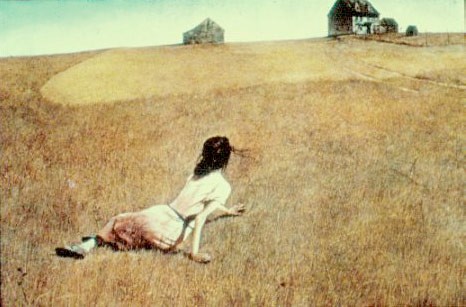
Wyeth “saw” Christina Olson free of her bonds ( Christina’s World, Fig. 10-8, 1948 ) amid stubble of a Maine hillside. Like Van Eyck angels, Christina’s image is rendered plausible by optical acuity of the Tempera medium.

Doors of German Cathedral at Hildesheim (Fig. 10-11 ) depict Adam and Eve in manner reflecting “nakedness” associated with Northern perspective on human figure.

Early Italian Renaissance interpretation of Expulsion by Masaccio (Fig. 10-16) suggests focus on grief in gesture and body-language. (Fig leaves added in later period.)

17th-cen. Flemish vision of Rubens (Fig. 10-18, top) depicts Adam and Eve embroiled in an Apocalyptic response to their Fall from Grace. This horrific pathos is in strict contrast to Mediterranean idealism with which Michelangelo had described Fall of Man and Expulsion roughly 100 years earlier on Sistene ceiling (Fig. 10-17, above).

Elevator perspective enabled Simone Martini to “describe” more fully the “reality” of Christ on the Road to Calvary (Fig. 10-20) by “stacking” receding figures and altering his “viewpoint” vertically.

“Modernism” edged Charles Sheeler’s architectural interior, Home Sweet Home, (Fig. 10-22, 1931) toward spatial distortions associated with traditional elevator perspective.

For the purpose of achieving as full a description as possible, Thomas Hart Benton varied his ”vantage-point” in Romance (Fig. 10-23, 1931-32). The observer’s eye travels on a vertical axis, surveying from above and below.

Linear perspective plays a role in Hopper’s Sunlight in a Cafeteria (Fig. 10-25, 1958), sharpening the artist’s focus on psychological tension between male and female figures in the stark interior.

“Primitive” artists violate spatial canons associated with Linear and Aerial Perspective, as in Fig. 10-27 (Mahantango Valley Farm, late 19th cen.,top) painted on a window-shade, and Fig. 10-28 (E. S. Field’s Joseph Moore & Family, 1839,above). Result is often heightened expressiveness characteristic of many post-Cubist images of the 20th century.
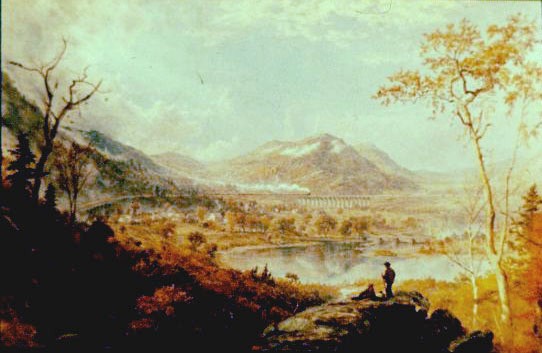
Early 16th-cen. Giorgione Adoration of the Shepherds “celebrates Nature” with little diminution of clarity (Fig. 10-29, top), while 19th-cen. Starrucca Viaduct (Fig. 10-30, above) by Cropsey follows optical precepts universally embraced as academic method of depicting “space” by the time of Giorgione’s death.

Roualt’s 1906 image, The Tragedian (Fig. 10-34) achieves Transcendental “meaning” by relying on aesthetic tools (implied “translucence”) rather than by power of his “descriptive” capacity.
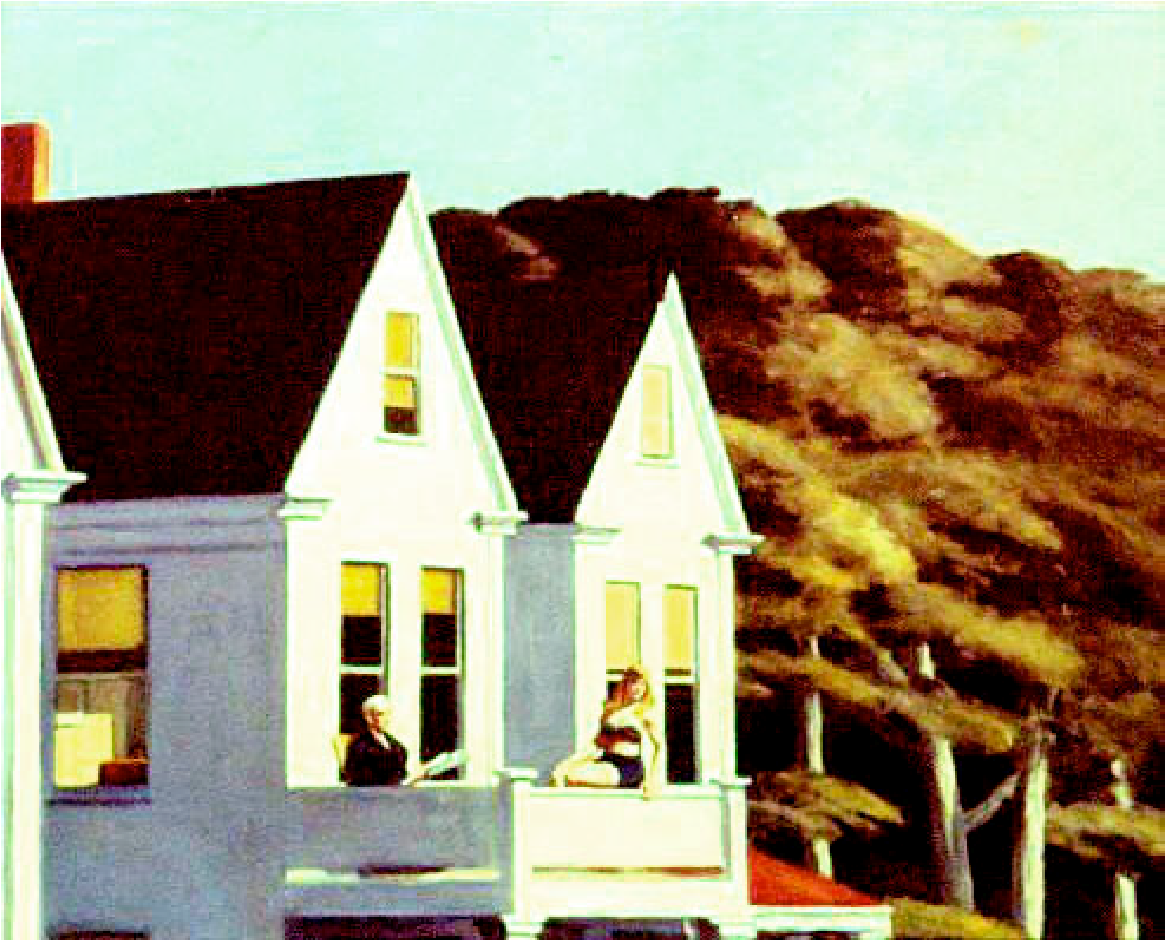
Hopper posits complex emotional undercurrent between “sun-worshiper” and elderly companion, while juxtaposing “primordial” forest and Spartan villa of Second Story Sunlight (Fig.10-36, 1960).
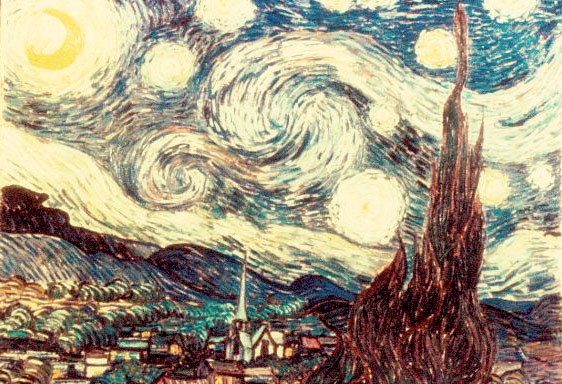
Van Gogh’s Starr y Night (Fig. 10-37, 1889) utilizes “planar” rather than illusionistic treatment of space.
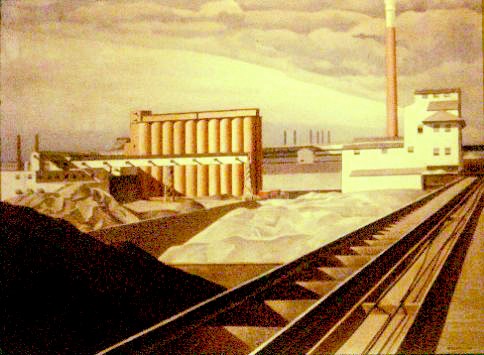
Sheeler’s Classic Landscape exploits deep space with illusionistic tools developed during the Renaissance (Fig. 10-38, 1931)
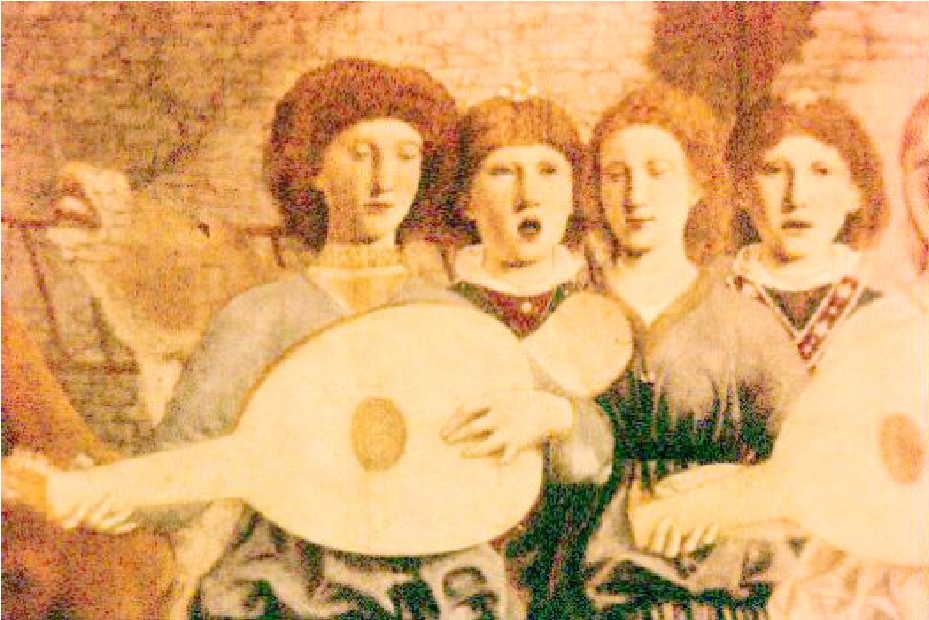
Piero della Francesca stretches credulity with elements of his Nativity of 1468 (Fig. 10-40, top, with detail), in part because of visual acuity of such elements as “translucent” donkey and psychologically complex choristers noted in detail above.

Experiments with irrational lighting give Rousseau’s Sleeping Gypsy (Fig. 10-41, 1897, top) and Tooker’s Sleepers (Fig. 10-42, 1959, above) dream-like attributes of fantasy. Spatial treatment heightens perception of transnatural “reality.”

Nocturnal lighting-conditions attracted study by 44-year-old Rousseau (Fig. 10-43, top) in monochrome View of the Ile St. Louis: Paris in the Evening, 1888. Illumination played increasing role in the artist’s later fantasies, which accorded diminished importance to Renaissance spatial logic. American artist, William Harnett (Fig. 10-44, After the Hunt, above) experienced European trompe l’oeil in Munich, further enhancing a market for moody nostalgia in U.S.

A stark New England landscape bathed in preternatural light offers Edward Hopper a vehicle for poetic appropriation of a familiar setting. (Fig. 10-46, Cape Cod Sunset, 1934).

Charles Sheeler took photographs of Shaker interiors as a metaphor of the new “functional idealism” of the post-War era ( The Open Door, Fig. 10-47).
